Remove your lawn. Find drought-resistant plants. Recycled water follows.

Tearing out our lawns is a good start toward wiser water use in Southern California, but it’s not enough.
To do the job properly, we also must be ready to collect the rain that will someday fall out of the sky, advocates say. And these people have a vision that not only stores increasingly precious rainwater but puts it to use for everything from drip irrigation to aquaculture to waterfalls surrounded by lush plantings and the soothing music of running (albeit recycled) water.
Yes, we’re in a drought, but this is about being ready for the next downpour.
“If we’re going to adapt to climate change, we need to recognize the impacts on the region, which means longer dry cycles and extreme rain events, so when it rains, it will rain more intensely,” said Melanie Winter, founder and director of the River Project, a nonprofit dedicated to protecting and restoring the Los Angeles River watershed. “We’re basically looking at aridification and flood.”
At a minimum, this means we should be installing gutters on our roofs, permeable walks and driveways around our homes and storage tanks in our yards — not barrels, because they’re not big enough to hold the water that pours off a roof in a single rainfall, Winter said.
For instance, just one inch of rain falling on a 1,000-square-foot roof could produce about 580 gallons of water for storage, making the 50-gallon rain barrels typically available at hardware stores “a waste of time and money,” Winter said.
Even with our drought conditions, Los Angeles has recorded about 12 inches of rain since July 2021, almost all (10.40 inches) of which dropped in December. If you’d had sufficient storage then, you could have collected more than 5,800 gallons of rainwater that month for irrigation.
Recycled rainwater bubbles out of a 500-gallon modular storage tank at a Hyde Park home. Water spilling over the rocks falls back into the tank below while providing water for pollinators.
(Mariah Tauger / Los Angeles Times)
Or consider this another way, said Winter. As we keep paving over more and more of Los Angeles, the little rain we do get quickly runs down our streets into riverbeds and the ocean, carrying all the pollutants it picked up along the way. If we save what little rain we get before it rushes down the street, we can slowly water our plants and feed our depleted groundwater at the same time, Winter said.
Rainwater harvesting doesn’t have to be complicated. Rebates for turf removal and water tanks can help cover expenses. Back in 2015, the River Project spent about $5,200 per home to retrofit 22 Panorama City homes with water storage tanks, greywater irrigation and permeable parkways and drives designed to catch runoff. All told, those homes could collectively capture more than 1.2 million gallons of water during a year of normal rainfall, the River Project estimated.
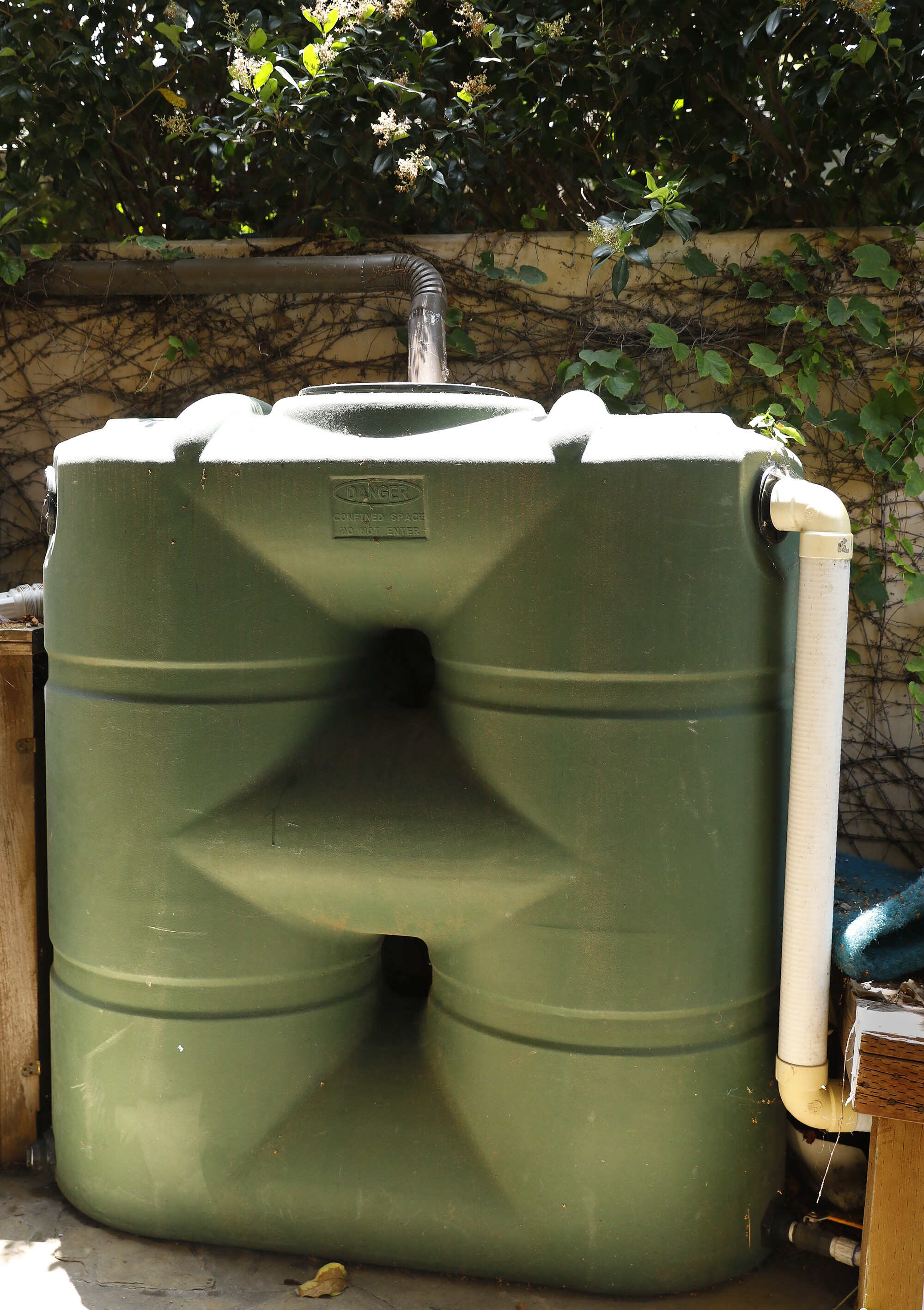
Mike Garcia’s yard had a Bushman Slimline tank, designed to fit flush against a wall as it catches 265 gallons of rainwater. The white pipe sends overflow to other tanks nearby.
(Christina House / Los Angeles Times)
Winter believes every house and yard in Southern California should be outfitted with rainwater harvesting tools because of the potential water savings. “Australia is way ahead of us on this,” she said, “because everybody there has a water tank.”
But like everything else these days, the prices for aboveground tanks and rainwater harvesting systems have jumped considerably. Mario Guerrero, a sales associate for Aqua-Flo Supply’s store in Ventura, said tank prices have increased by 20% to 30% in the last year. “Everything petroleum-based has skyrocketed — plastic tanks, PVC pipes, fittings. It’s not like it was a few years ago.”
Today, a 1,000-gallon Norwesco tank that “looks like a giant soda can” costs nearly $1,500 at Aqua-Flo, if you pick it up at the store. A waffle-shaped 530-gallon Bushman Slimline tank, designed to sit flush against a wall, is around $1,700, Guerrero said.
If you’re willing to dig a hole, Eco-Rain Tank System’s modular system costs around $300 to $500 for 300 gallons of storage, plus the cost of an impermeable liner, said sales manager Mary Angle, noting that prices have nearly doubled in the last year.
Making landscaping sexy with recycled water
Those costs were even lower when landscape contractor Mike Garcia of Enviroscape L.A. took out his front and back lawns more than 15 years ago, along with his swimming pool, during a remodel of his Redondo Beach home. He meshed his interest in water conservation with his landscape design aesthetic to create waterfalls in his front and back yards powered by recycled rainwater and a koi pond. The fish-poop-enriched water nourishes Garcia’s towers, raised beds and pots filled with fruit trees, vegetables and low-water plants, including native plants.
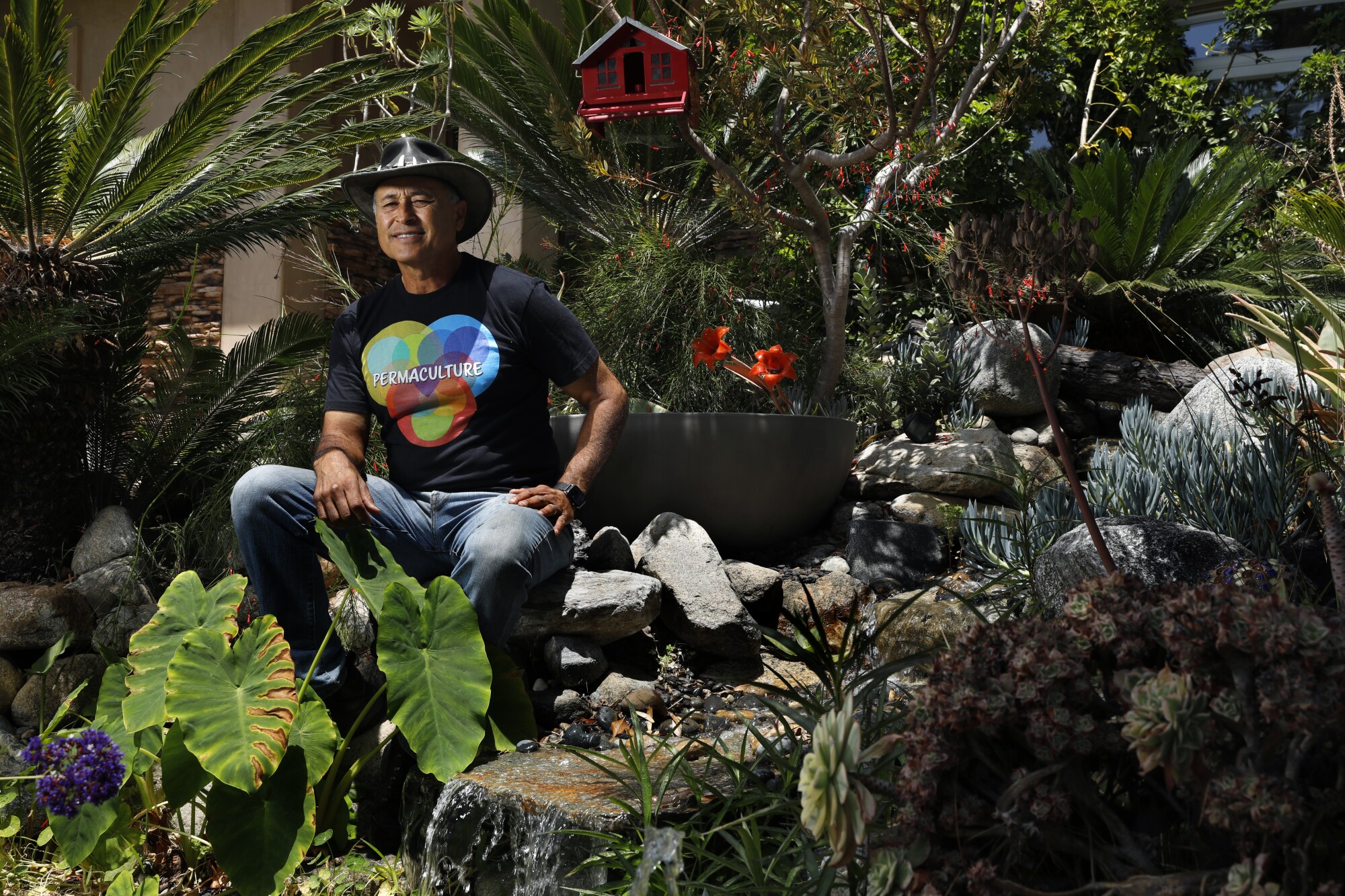
Mike Garcia removed the lawn and added a recycled water waterfall system and low-water plants in his front yard.
(Christina House / Los Angeles Times)
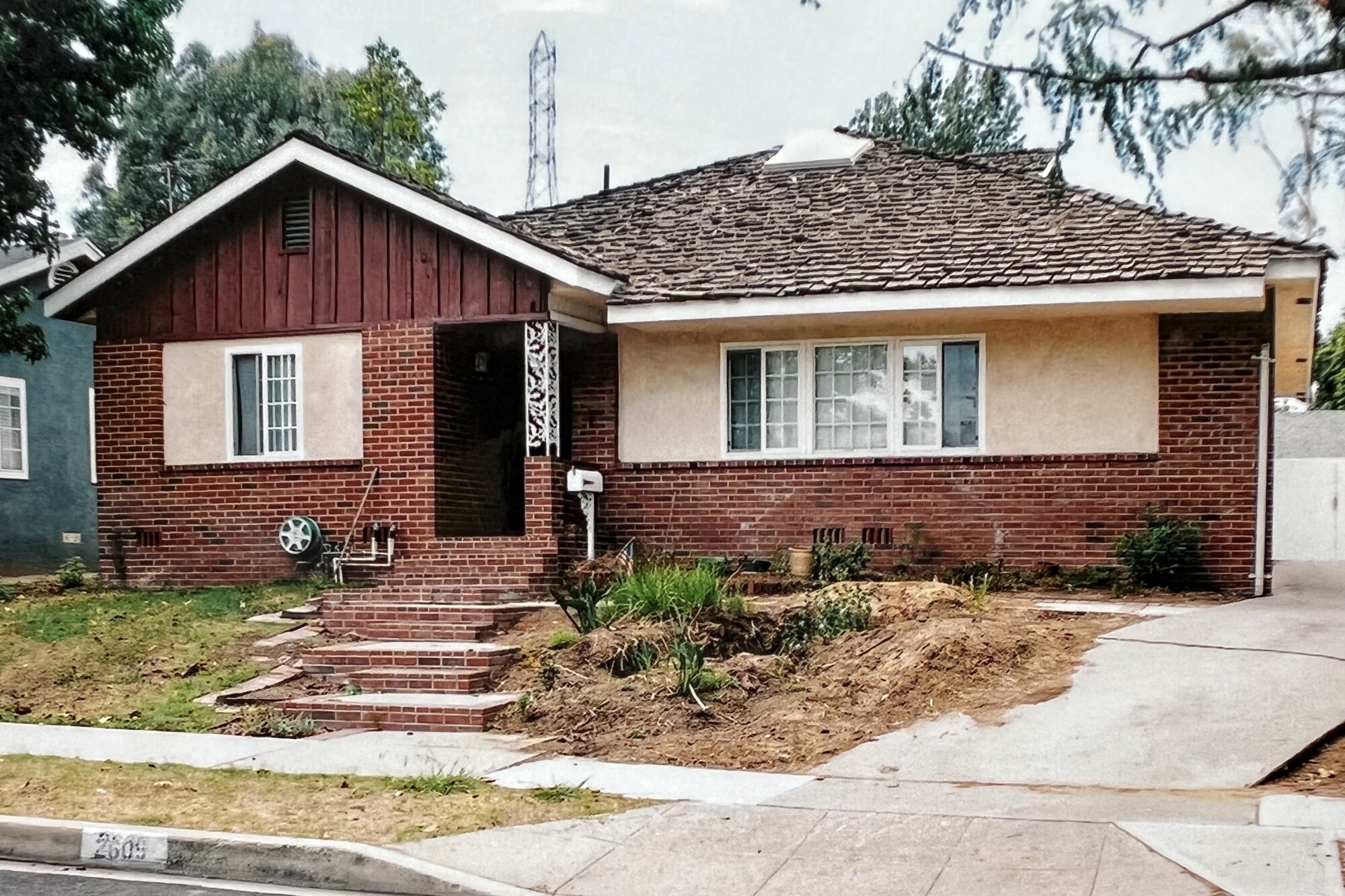
Mike Garcia’s home in 2007, before he replaced the front lawn.
(Mike Garcia)
He also has raised-bed vegetable gardens in the parkway between the street and sidewalk in front of his home that use a drip irrigation system connected to his rainwater storage.
Of course, it helped that he was able to convert most of his swimming pool into more than 5,000 gallons of water storage (using Eco-Rain tanks) covered by a permeable patio that allows rainwater to seep into the tanks.
His partially permeable driveway helps fill the underground tanks in the front yard, and the gutters on his house drain into a 265-gallon Bushman Slimline tank in the backyard. When that tank is full, the overflow is piped to the underground tanks in his former swimming pool. (Garcia paid about $600 for his Bushman Slimline tank in 2014; today the same tank is nearly $1,100 at Aqua-Flo.)
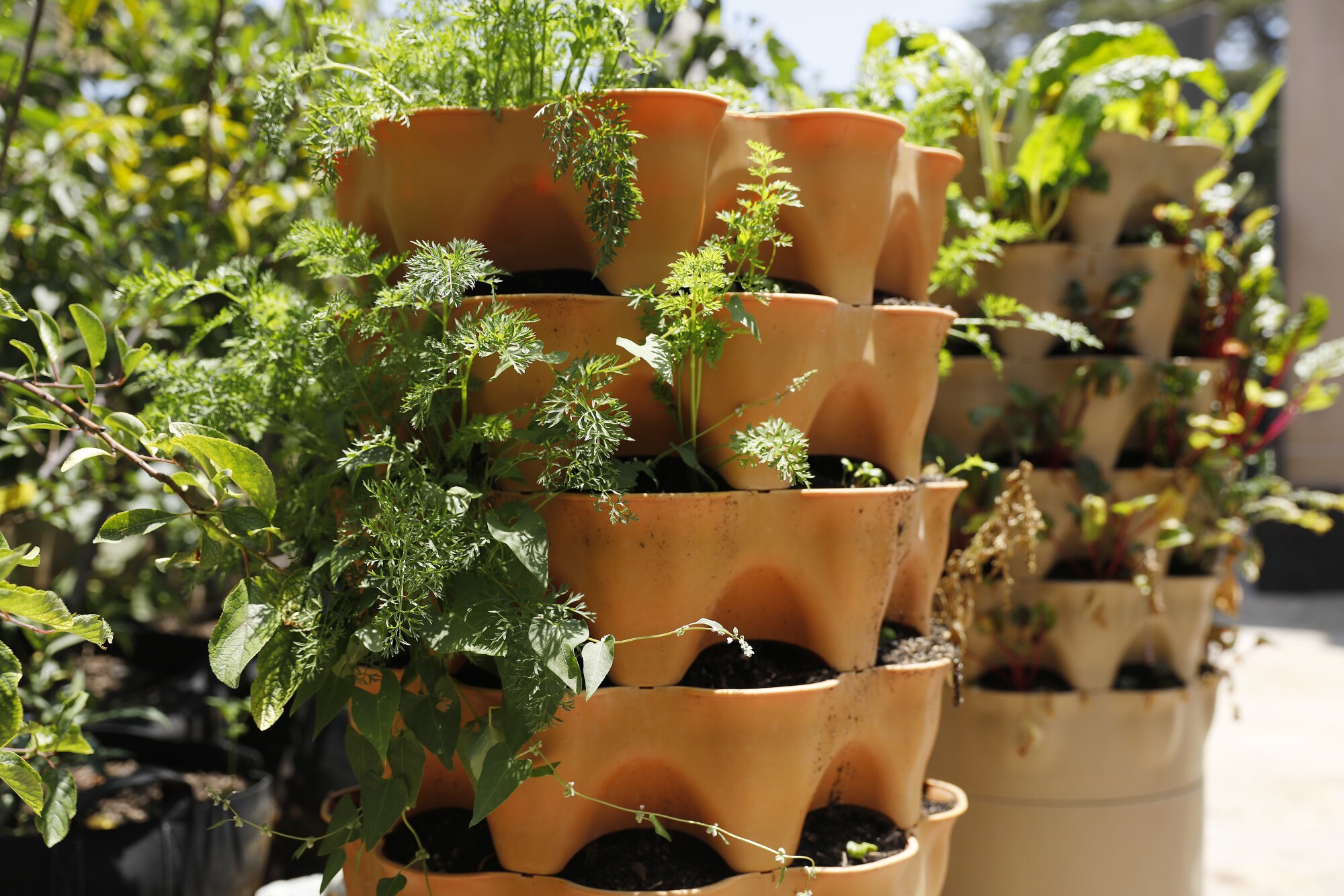
Plants in Mike Garcia’s yard are watered through a drip irrigation system that draws on recycled rainwater.
(Christina House / Los Angeles Times)
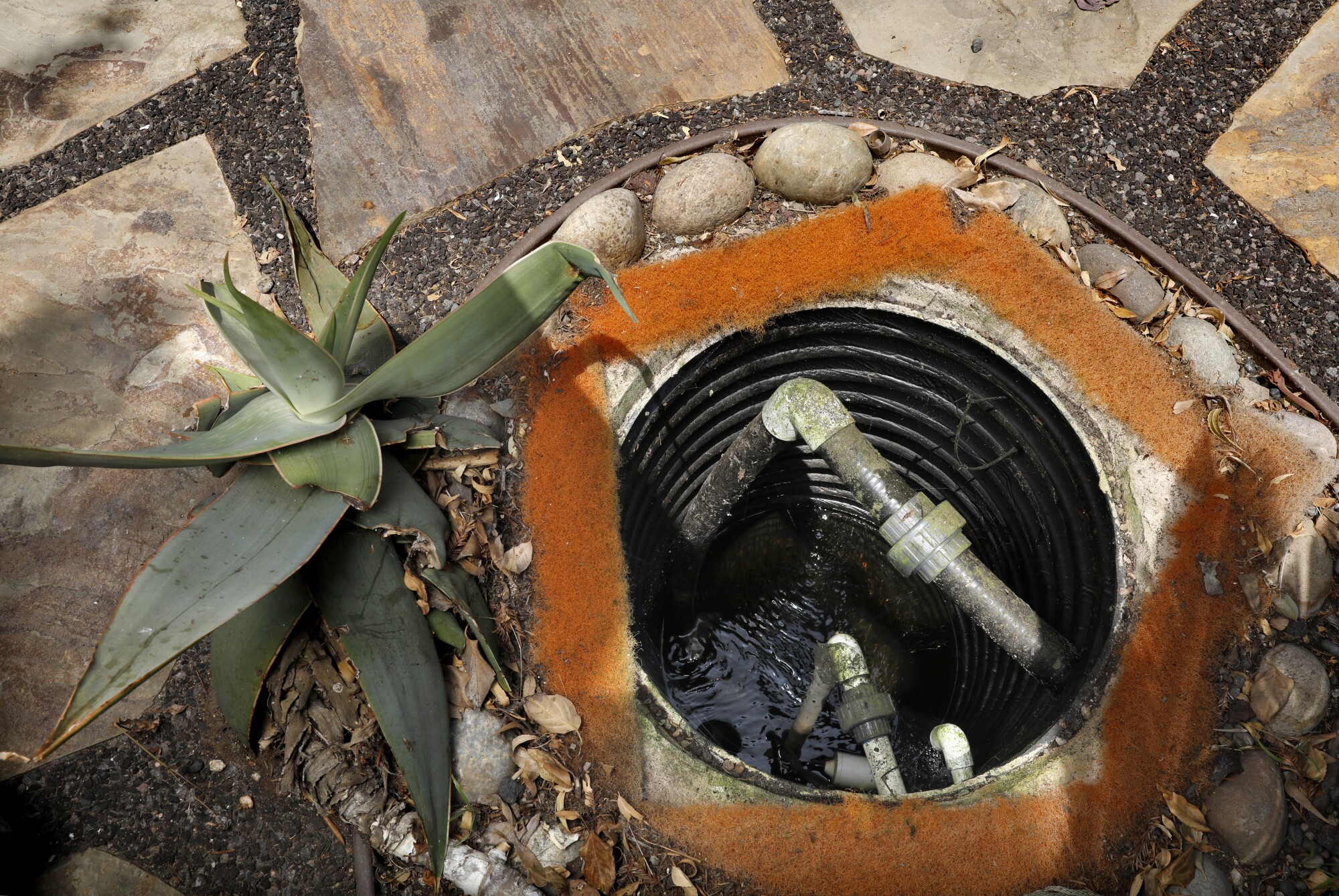
Water flows through a pipe into the underground storage in Mike Garcia’s converted swimming pool. The “grout” between his patio paving stones is permeable, allowing rainwater to drip into the storage tanks below.
(Christina House / Los Angeles Times)
He could have just installed a bubbler to keep his stored water aerated, but he figured, why not make it interesting?
“The goal in landscaping is to dazzle the senses and soothe the soul,” Garcia said. “I mean, if you’re going to install a tank, what will you do with all that extra soil after you dig a 5-foot-deep hole? You can make it all a little sexier by using that dirt to build a waterfall.”
Garcia has been in the landscaping business for nearly 40 years, and has been focused on water conservation for more than 30, he said.
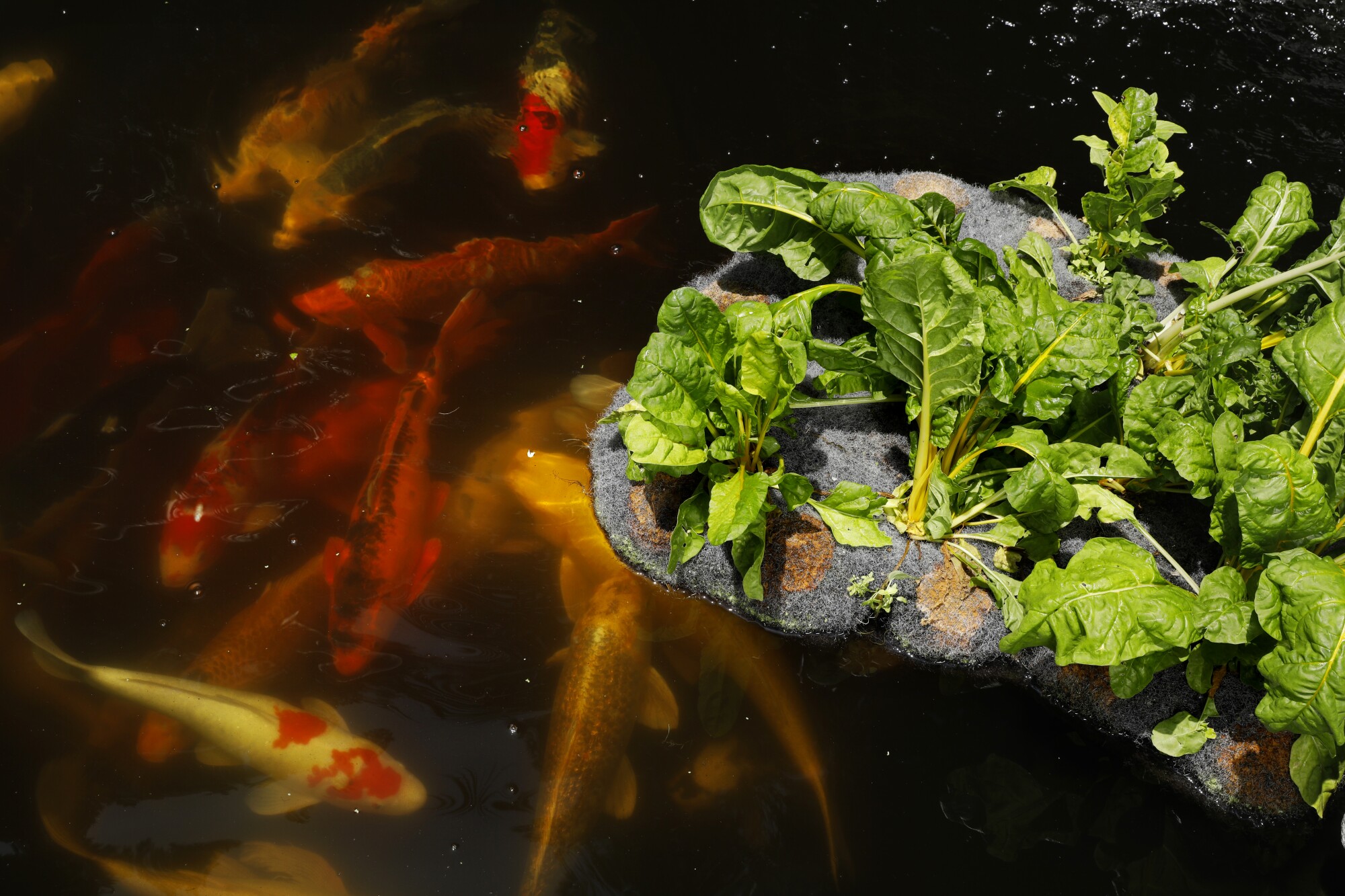
A small island of chard floats in a nutrient-rich koi pond, one of Mike Garcia’s backyard experiments in growing food using recycled rainwater.
(Christina House / Los Angeles Times)
He’s also a big experimenter. Garcia said he created ways to recycle irrigation water in raised vegetable beds and recently added aquaponics to the equation, using water from his koi pond to nourish his vegetable plants. His backyard is full of vegetable grow towers he’s testing and a floating “island” of chard in the pond.
He even inspired Jordan Karambelas, a high school student in Manhattan Beach, to build a 4-by-8-foot aquaponic system using recycled water. The two tiers include 40 goldfish on the lower level and raised vegetables above. Water enriched by fish poop is constantly pumped into the vegetable bed, where it drips back down to the fish tank below.
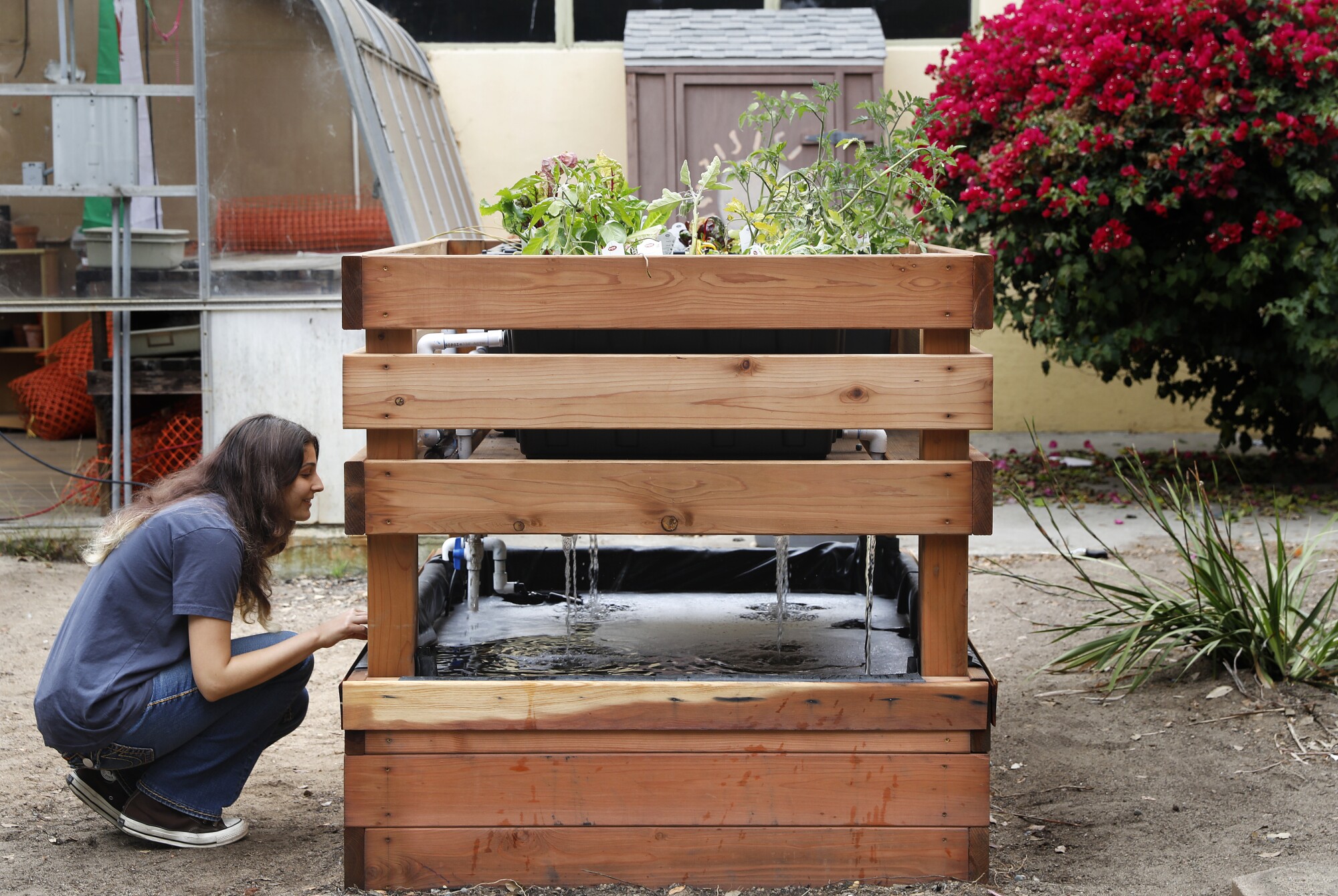
Jordan Karambelas crouches by the raised redwood vegetable bed watered by an attached fish pond.
(Christina House / Los Angeles Times)
Garcia’s focus is on creating water-efficient, organic and sustainable gardens, but he said he’s discovered that even the most water-conscious people still want a yard that’s alluring.
“Angelenos want something colorful and drought-tolerant that feeds the butterflies,” he said. “Even if you want to grow food, how do you make it sexy? You build a pond or a fountain, grow the food around it and always have a great selection of native plants for the pollinators.”
Garcia loves talking about his projects. He’s made dozens of videos explaining what he does, including one describing his backyard rainwater storage system, and he offers free tours of his home landscape the first Saturday of every month from 2 to 4 p.m. at 2609 Vargas Way (the next tour is Saturday, July 2).
Nourishing a South L.A. microfarm
Garcia’s recycled-water approach inspired Jamiah Hargins in 2020 to create Crop Swap L.A., which turns South L.A. lawns into microfarms. As part of the conversion, he uses modular underground Eco-Rain tanks, rain gutters, drip irrigation and recycled water to help vegetables thrive on just a fraction of the water needed to keep a lawn alive.
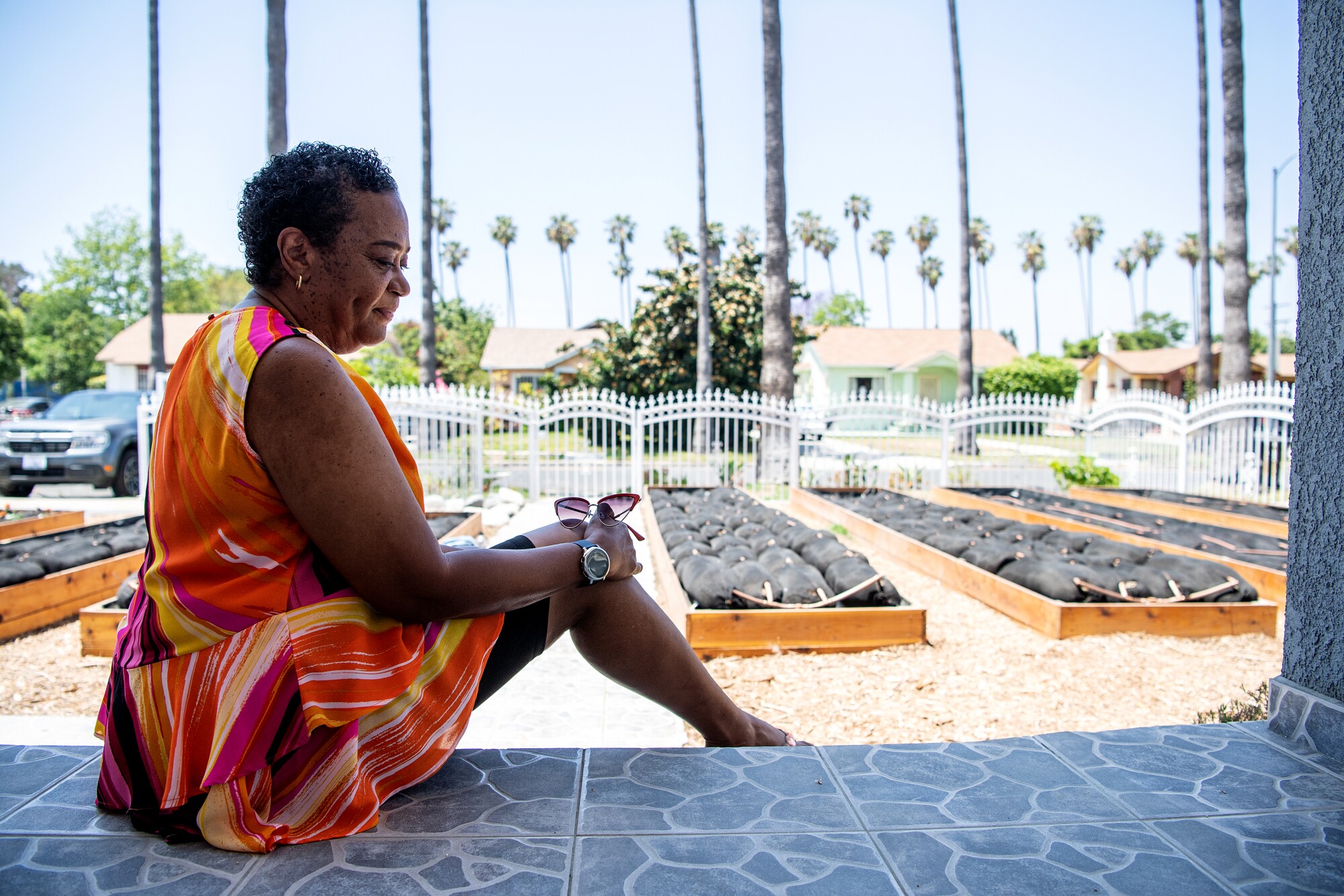
Beverly Lofton at her home in Hyde Park, where her front lawn has been turned into a microfarm using recycled water.
(Mariah Tauger / Los Angeles Times)
Crop Swap L.A.’s second project is nearly complete in the tidy, 600-square-foot Hyde Park front yard of Beverly Lofton. She named the project La Salle Microfarm in honor of her late husband, La Salle Lofton, who had a catering business. He was known as the BBQ Man and loved to feed people, she said, so creating a farm to feed others in his neighborhood seemed like the perfect tribute.
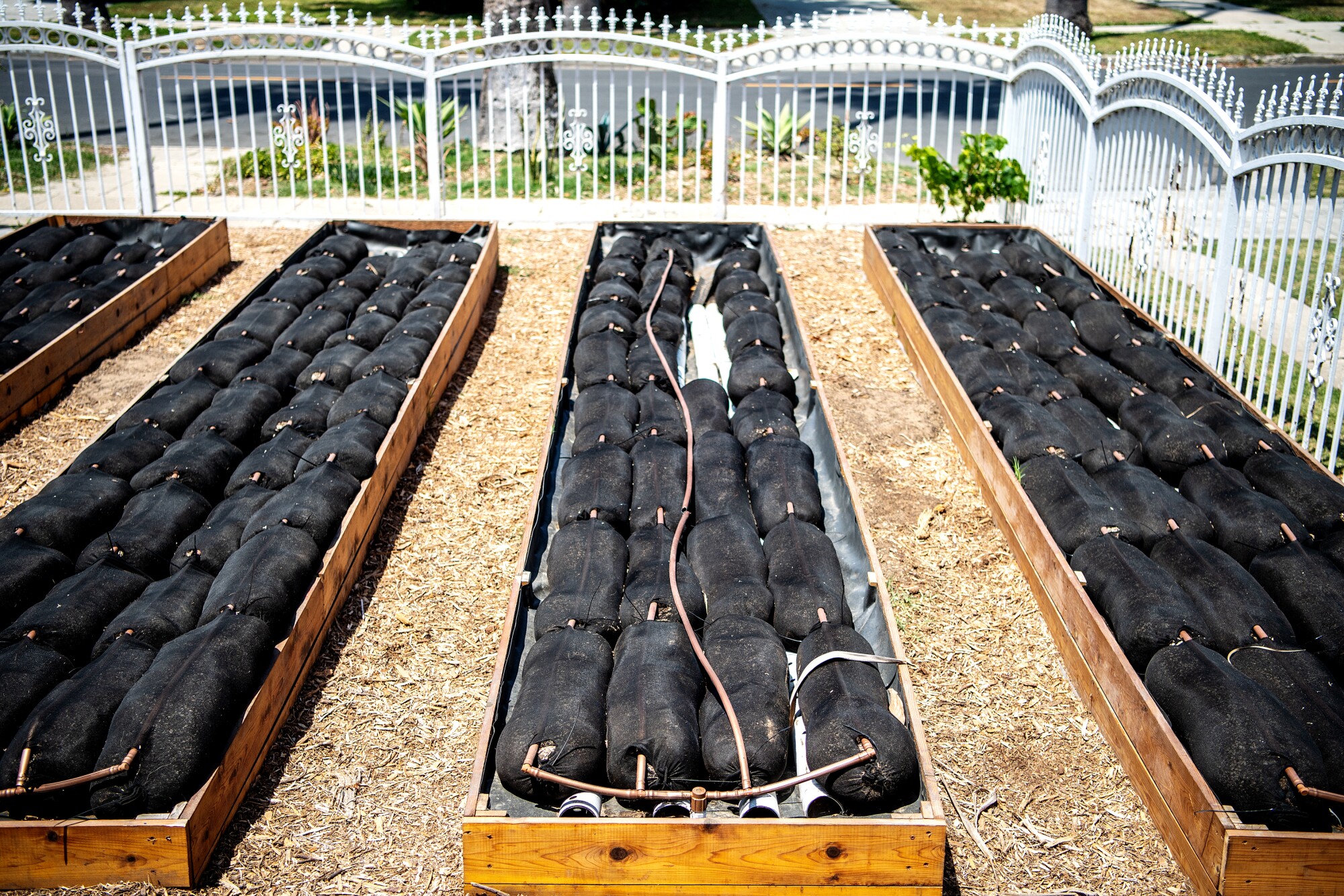
La Salle Microfarm fills its raised beds with sausage-like bundles of soil on top of impermeable pond liner. The runoff from watering the plants can be collected and diverted back to the storage tanks, where it is used again and again for irrigation.
(Mariah Tauger / Los Angeles Times)
Hargins’ goal is to create at least 400 front-yard microfarms in South L.A. supported by 30 to 50 subscribers who live within a mile of the farm. For a monthly fee of $50, subscribers can get a box filled with greens and vegetables every week ($35 for a box every two weeks). That helps support the maintenance and expenses of running the farms (La Salle is managed by Crop Swap employee Temu Martin-Bey). But it’s up to the homeowners to cover the cost of lawn removal and setting up the farm.
That setup is a lot of work. The La Salle Microfarm has six long raised beds lined with impermeable pond liner and filled with bundles of compost-enriched soil, stuffed into sausage-like mesh casings known as Garden Soxx. When completed, the raised beds look like they’re filled with little sleeping seals. Martin-Bey and his crew string drip irrigation through the bundles and then make holes to plant the seedlings.
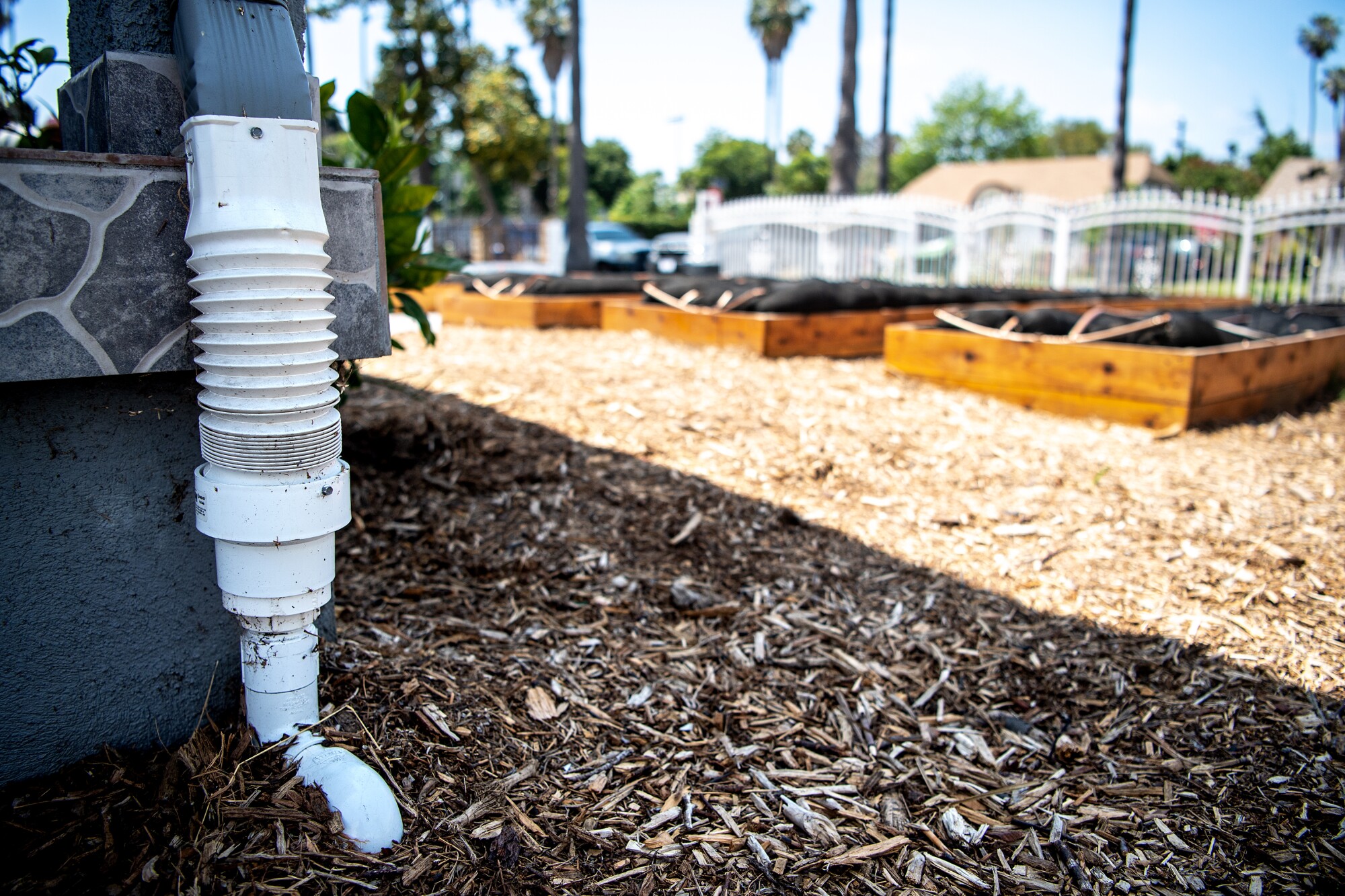
Gutters on Beverly Lofton’s Hyde Park home collect rainwater off her roof and send it to the water tanks underground.
(Mariah Tauger / Los Angeles Times)
Runoff from the drip irrigation runs back to the underground Eco-Rain storage tanks, which hold about 500 gallons. A small bubbler fountain keeps the recycled water aerated so it doesn’t stink while also providing a place for hummingbirds, bees and other pollinators to get a drink.
The project included putting gutters on Lofton’s house that drain to the underground tanks, which are also hooked up to city water. If the levels fall too low, the tanks automatically refill from the municipal system.
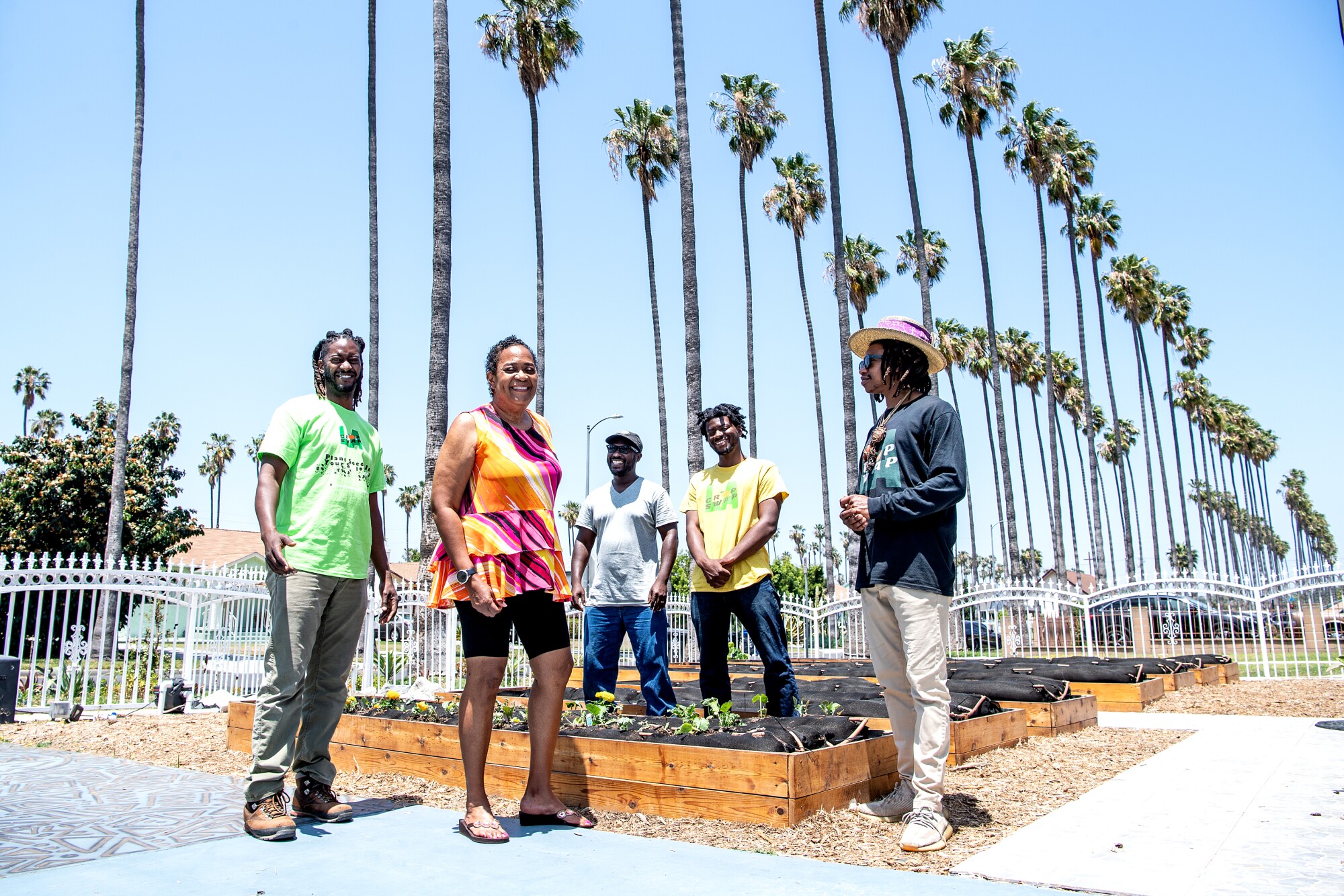
Beverly Lofton in her new front yard — the La Salle Microfarm — with, from left, Jamiah Hargins, founder of Crop Swap L.A., Justinian Osei-Akosa, Crop Swap’s pest specialist, Ryan Fleming, farm assistant, and Temu Martin-Bey, the farm manager.
(Mariah Tauger / Los Angeles Times)
It cost about $30,000 to get the microfarm established, Lofton said, after the $4,590 turf removal rebate she got from the Metropolitan Water District. That’s a hefty bill, but Lofton said she didn’t have the expertise to do the conversion herself and now her water bills have been reduced from more than $400 every two months to under $200. Plus, as the landowner, she gets free produce once the farm starts producing.
“To me (the expense) is worth it for the satisfaction of being able to feed people and doing something with the lawn besides looking at it, because basically it was just there,” she said. “I believe in trying to do something positive for society when it is in my power to do so, that will benefit myself and others and be an example of what can be done.”
Lofton also loves the idea of creating a legacy with her front yard. “I remember my grandparents and most of my relatives from that generation having beautiful gardens that fed us for years,” she said. “I hope to pass that on to the next generations.”




